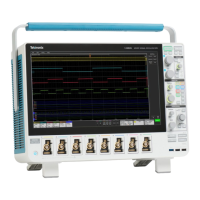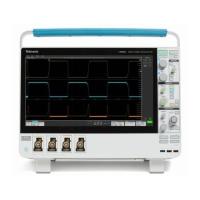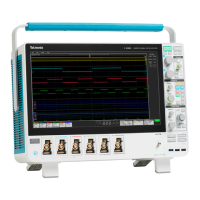3. The Results Bar contains controls for displaying cursors, adding notes, plots, and result tables to the screen, and add
measurements to the Results bar. The controls are:
■
The Cursors button displays on-screen cursors in the selected view. Touch and drag, or use the Multipurpose knobs,
to move the cursors. Double-tap on a cursor, or on the cursor readouts, to open a configuration menu to set cursor
types and related functions.
■
The Measure button opens a configuration menu from which to select and add measurements to the Results bar. Each
measurement you add has a separate badge. Double-tap a measurement badge to open its configuration menu.
■
The Results Table button adds a Measurement or Bus Results table to the screen. The Measurement Results table
displays all measurements present in the Results bar. The Bus Results table displays bus decode information for
displayed bus waveforms. Each table is contained within its own view window, which can be moved within the display
area.
■
The Note button adds a note object to the selected view. Double-tap the note text to open a configuration menu to
change the text and font characteristics. Drag the note to any location on the view. Notes cannot be added to a
Results Table view.
■
The Search button lets you detect and mark a waveform where specified events occur. Tap Search to open a Search
configuration menu and set the search conditions for analog and digital channels. You can add any number of
searches to the same waveform or to different waveforms. Search badges are added to the Results bar.
■
The Plot button adds an XY, XYZ, or Eye Diagram plot to the display. These plots are contained within their own
window and can be moved within the overall display area.
■
The Measurement and Search badges show measurement and search results. and are displayed in the middle area
of the Results bar. See Badges on page 19. See Add a measurement on page 40. See Add a Search on
page 45.
■
The Draw-a-Box button at the bottom of the Results Bar lets you draw a box on the screen to zoom in on an area of
interest.
■
The Trash Can icon lets you drag Channel, Waveform, Measurement, and Search badges to the Trash Can to delete
them.
4. The Settings Bar displays System badges for setting Horizontal, Trigger, Acquisition, and Date/Time parameters; Inactive
Channel buttons to turn on channels; Add New Waveform buttons to add math, reference, and bus waveforms to the
display; and Channel and Waveform badges that let you configure the individual waveform parameters. Tap a channel or
waveform button to add it to the screen and display a badge. Double-tap any type badge to open its configuration menu.
See Badges on page 19.
5. Configuration Menus let you quickly change the parameters of the selected user interface item. You can open
configuration menus by double-tapping on badges, screen objects, or screen areas. See Configuration menus on page 24.
The user interface elements
Each area of the user interface has a specific function that helps manage information or controls. This topic shows and describes
the key user interface elements.
Getting acquainted with your instrument
16 MSO54, MSO56, MSO58 Installation and Safety Manual

